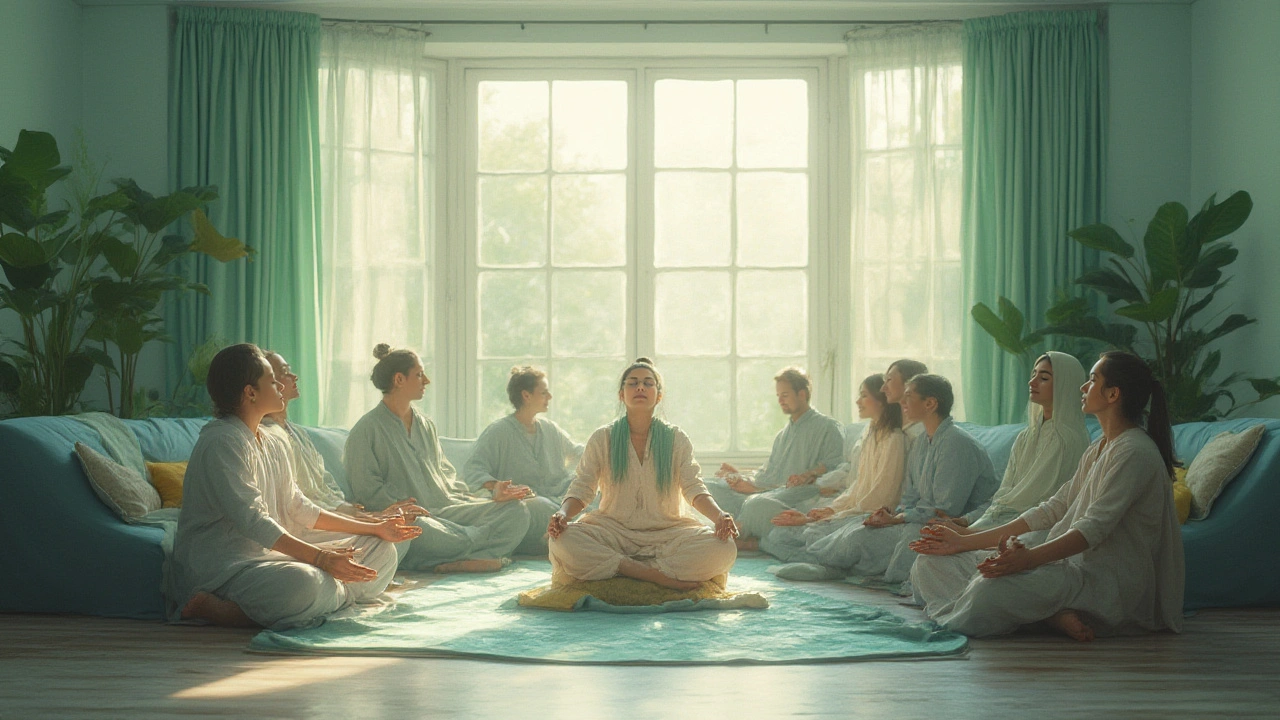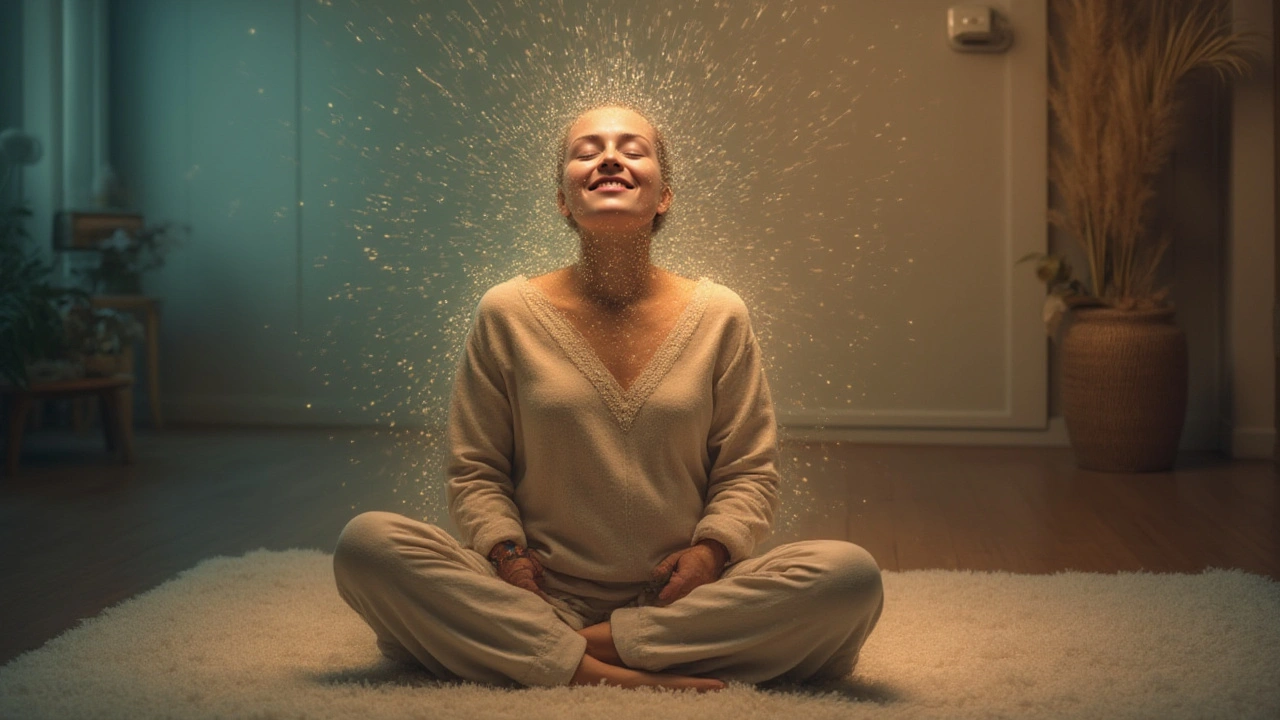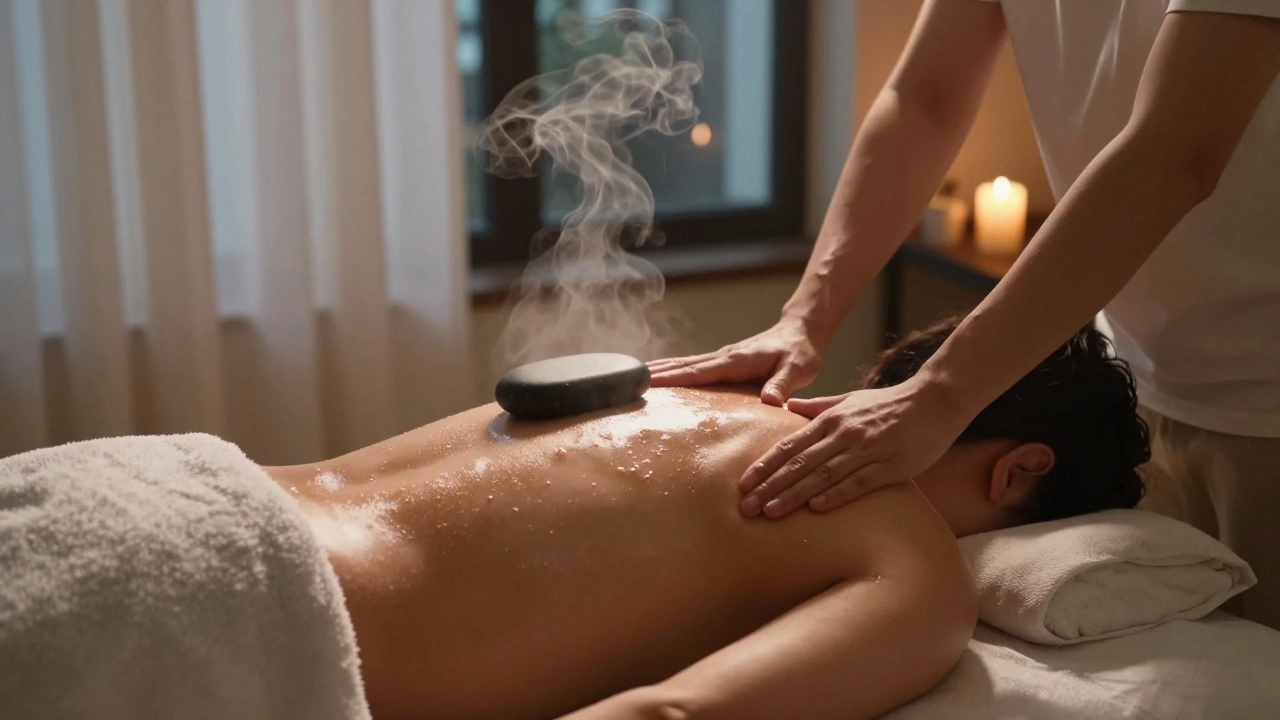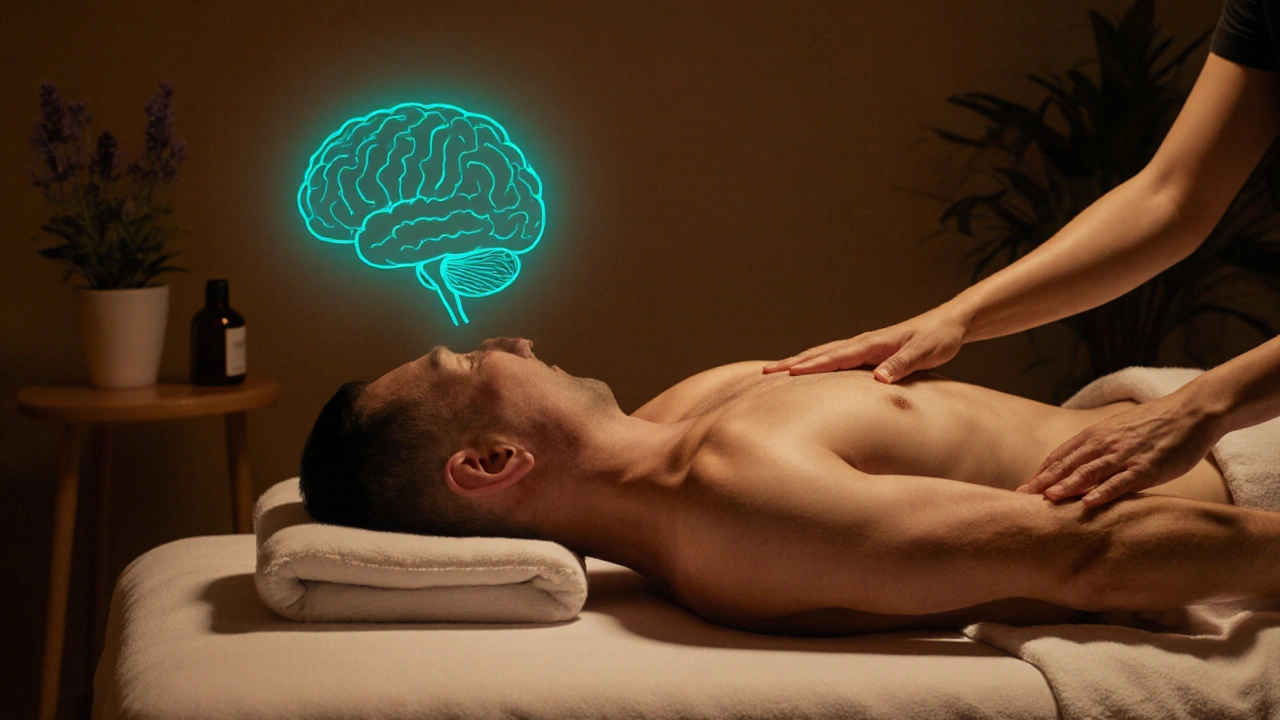Body massage does way more than just loosen up sore muscles. It’s a trusted way to manage stress and anxiety for people from all walks of life. This article breaks down how massage works, what kinds are out there, what you can expect during a session, and how to find the right service near you. Expect clear explanations and real-world tips to help you decide if massage therapy is a good fit. Whether you’re feeling burnt out or just curious, you’ll find practical answers here.

- Created by: Elara Wainwright
- Completed on: 17 Jul 2025
- Categories: Head Massage
Key Points
- Indian head massage is designed to unblock energy pathways, reduce stress, and soothe tight muscles in the scalp, neck, and shoulders.
- It’s famous for relieving headaches, improving sleep, boosting circulation, and helping you shed built-up tension from long workdays or heavy emotions.
- Besides physical benefits, Indian head massage supports mental clarity and emotional balance by gently encouraging your body’s own ability to heal.
- There are several styles available in London, from traditional Ayurvedic techniques to modern spa adaptations, each with their unique touches.
- Sessions usually last 30-45 minutes and cost anywhere from £30 to £70, depending on the location and therapist experience.
Direct Answer – What Does Indian Head Massage Unblock?
Indian head massage clears blockages in what practitioners call your body’s energy pathways. If you’ve ever felt a fog settle over your mind after a tough day, or found your shoulders up around your ears from nonstop stress, you know how tension builds up. Indian head massage goes right to the sources of these knots – the scalp, neck, and shoulders – and works to free them up. It’s not just about loosening muscles, though that happens too. The massage helps shift stagnant energy, also called prana in Ayurveda, to help you feel lighter, brighter, and maybe even a little more human again. People say it unblocks headaches, lifts sluggish moods, and lets you breathe a bit easier, both physically and mentally.
Comprehensive Guide to What Indian Head Massage Unblocks
Let’s be honest: most of us spend hours glued to screens, hunched over phones, or lost in endless to-do lists. This tension creeps into our heads, necks, jaws, and even our thoughts. The thing is, stress doesn’t just sit in your mind – it actually sinks into your muscles and can twist your energy up tight, too. Indian head massage is like a gentle tune-up for your entire system. It’s often called Champissage in India and has been a self-care staple there for generations. Imagine someone kneading away the knots you didn’t even know existed, from your temples to your shoulder blades. That warm, floaty feeling after? That’s the blocked energy finally finding a way out.
There’s something a bit magical about how it all works. In Ayurveda, every part of your body is said to be connected by energy channels known as Nadis. When these get blocked – by stress, poor posture, emotional buildup, or even just modern life – the body can react with headaches, hair loss, eye strain, insomnia, or irritability. Indian head massage uses rhythmic movements and pressure points to sweep away these blockages, so you can get back to your natural state of flow. You know that sensation after a good shower or when you first lie down at night and let out a deep breath? Multiply that by ten, and you’re close.
Modern research agrees with the tradition. A small-scale UK study saw participants report better sleep and less anxiety after just a few weekly sessions. And therapists often blend gentle hair pulls, circular rubbing, and shoulder squeezes to cover all bases. London, with its fast pace, has seen Indian head massage pop up in everything from luxury spas to airport lounges, proof that people can’t get enough of its de-stressing powers. If you’re looking for a break from racing thoughts or relentless migraines, it’s a practical, gentle option.
Definition and Context: What is Indian Head Massage and Why Should You Care?
In plain English, Indian head massage is a therapeutic treatment that targets your scalp, neck, upper back, shoulders, and sometimes even your face. The roots can be traced back to families in India, where mothers would massage their children’s heads to help with growth, stress, or even just family bonding. Instead of using special machines or lotions, the therapist relies on their hands—fingers, knuckles, and palms—to cover every inch of the treatment area. Sometimes, they’ll add a bit of fragrant oil, usually coconut or sesame, to boost relaxation and nourish the hair. But you never have to get your hair oily if that stresses you out. Dry massages are just as popular in London salons.
Why does all of this matter? Let’s be real: we live in a world where self-care often falls to the bottom of the list. Indian head massage is almost like a shortcut to deep relaxation, without stripping down or committing to a two-hour ordeal. “It’s about more than just physical relaxation—this therapy aims to restore energetic balance so you feel whole again,” notes Dr. Monica Grover, a medical director at VSPOT Medispa in New York.
“Studies suggest head massages may lower cortisol levels, our primary stress hormone, which has ripple effects all through the body.”You don’t need to believe in chakras to feel the calming results—everyone benefits when stress takes a backseat.
People flock to Indian head massage because headaches, eye strain, jaw tension, and anxiety are everyday struggles. Ever had one of those days where your brain feels trapped in a pressure cooker? Instead of powering through, Indian head massage offers a way to hit reset. It’s also portable—you can receive a quick session seated in a chair, with your clothes on, in an office, living room, or spa.
Benefits of Indian Head Massage: From Unblocking Energy to Tangible Results
You might be wondering, so what’s the big deal? People who try Indian head massage often rave about immediate results. They walk in frazzled, jaw clenched, and shoulders up to their ears, yet stroll out looking lighter, sometimes even blissfully dazed. But what exactly gets “unblocked”?
- Relief From Headaches and Migraines: By boosting blood flow to the scalp and relaxing tense muscles, Indian head massage can melt away tension headaches or migraines. If you’ve ever had a pain creep up from your neck after long meetings, you get the appeal.
- Reduced Stress and Anxiety: The gentle pressure applied to the temples, forehead, and base of the skull tells your nervous system it’s time to calm down. You might even feel a tingling sensation, the kind that ripples through stress knots and leaves you floating.
- Better Sleep: Clients often report falling asleep more easily or experiencing deeper rest after a session. That’s because the treatment helps lower stress hormones, quiets racing thoughts, and signals the body to unwind.
- Improved Mood and Clarity: Unblocking the energetic “traffic jams” in your head can spark mental clarity and boost your mood. When energy is free to move, you’re less likely to stew in negative thoughts or overwhelm.
- Healthier Hair and Scalp: Those rhythmic, sweeping movements also help distribute natural scalp oils. This nourishes hair follicles and can encourage healthy growth. Some salons even include custom herbal oils to further boost shine and scalp vitality.
- Tension Release in Shoulders and Neck: If you spend all day hunching over screens or carrying heavy bags, expect some major shoulder relief. Many people say the massage starts as a head treatment but ends up releasing pain carried deep in the neck and upper back.
A British study published in the International Journal of Neuroscience discovered that participants showed less anxiety, lower blood pressure, and a brighter mood after a series of Indian head massages. Clients often liken it to “wiping the mental slate clean,” or even unlocking a wave of creativity just when they need it.
Types of Indian Head Massage Available in London
While the roots are traditional, the ways to enjoy Indian head massage in London are as diverse as the city itself. If you’re wandering through Soho, Brixton, or tucked-away mews, you’ll find different spins based on where you book and who’s treating you. Here’s what’s out there right now:
- Ayurvedic Champissage: This is the classic, rooted in ancient healing wisdom. The focus is on balancing your energy (or doshas) using a mix of thumb pressure, circular strokes, and gentle hair-pulling techniques. Oil or no oil—it’s your call.
- Modern Spa Indian Head Massage: Think luxurious oils, calming music, and maybe even hot towels pressed against your neck. These settings are a bit more pampering, perfect for someone wanting to really splash out.
- Seated Workplace Massage: Popping up in offices and even co-working spaces, these shorter sessions zero in on neck, scalp, and shoulders while you sit fully clothed. A game-changer for tense afternoons.
- Holistic Studio Sessions: Some therapists in East London, for example, blend head massage with Reiki or reflexology for a more tailored holistic experience. It’s a real mix-and-match approach.
- Festival or Pop-Up Massages: Not just found at spas—you might stumble across a quick Indian head massage at a yoga festival, wellness market, or even a posh event.
Each option has its own vibe. Want traditional? Go Ayurvedic. Fancy a spa day? Head to a boutique hotel. Need a lunchtime boost near the office? There’s probably a mobile therapist nearby. Just know that whether it’s dry, with oil, quick, or long, the point is the same: to help you feel renewed by unblocking whatever tension or energy has piled up.

How to Find Indian Head Massage Services in London
London is flooded with options, from seasoned therapists with glowing reviews to low-key home studios. Googling "Indian head massage near me" yields a dizzying list, but here’s how to cut through the noise:
- Start with Recommendations: Ask friends who value self-care or check online forums. Look for people who mention real results, not just spa decor.
- Check Qualifications: Seek practitioners with training in traditional Champissage or Ayurveda. The London Centre of Indian Champissage is famous for certifying many local therapists.
- Browse Based on Location: From Camden to Clapham, shortlist nearby therapists for shorter commutes and easy follow-up visits.
- Read the Reviews: Real clients will mention if the therapist truly listens and adapts to your comfort level, whether you want more scalp work or extra focus on stiff shoulders.
- Look for Special Offers: Lots of solo practitioners or new studios offer intro discounts. Don't be shy to ask for deals.
For visual types, plotting options on Google Maps can help. Pick a place near a cozy coffee shop or park so you can drift out and stretch the relaxation even longer. Some therapists are mobile and can visit your home or office, a nice perk if you want to avoid post-massage travel.
What to Expect During a Session
Alright, let’s paint a picture. You walk in and, depending on where you go, the room might smell faintly of sandalwood or be softly lit. You’ll usually keep your clothes on—just loosen jewelry or ties. The therapist might ask where you’re holding the most tension, or if you have any headaches or stiffness. If oil is involved, they’ll check if you’re cool with getting your hair a little messy; otherwise, they’ll do a dry version.
You settle into a comfy chair or low massage table. The massage starts on your shoulders, kneading through the thick muscles where stress likes to hibernate. Then, gentle strokes move up your neck, working into the scalp with circular motions, gentle tugs, and rhythmic tapping. Don’t be surprised if you feel a little tingly—this is the energy starting to shift. Some people feel instant relaxation, others notice a drop in headache or jaw pain. A good therapist will check in, making sure you’re comfortable at each step.
The session usually takes 30-45 minutes, though some offer mini versions for busy schedules. Afterward, you may feel a rush of clarity, a weird lightness, or even a bit emotional. That’s just your body processing the stress that’s finally leaving. Drink water, go for a slow walk, and give yourself a moment to adjust. It’s not uncommon to sleep deeper or feel mellow for the rest of the day.
Pricing and Booking
Let’s talk money—Indian head massage is usually one of the more budget-friendly treatments. In London, you can expect prices between £30-£70, depending on location, therapist experience, and length of session. Fancy hotel spas will run higher. For professional, qualified therapists in central London, £45-£55 is about standard for 45 minutes.
Booking is easy—most therapists use booking sites, have direct online forms, or even work through wellness apps. Same-day appointments can be tough, especially for after-work slots, so plan ahead if you’re particular about timing. Don’t forget to check for cancellation policies. Sometimes you’ll get a loyalty card after a few visits, or a discount for booking a package.
Safety Tips
Any massage should feel safe and tailored to you. Before booking, double-check the therapist’s credentials. Look for proper hygiene—fresh towels, a clean workspace, and handwashing are non-negotiable. People with certain conditions (recent injuries, migraines triggered by touch, or skin issues) should mention this upfront. If anything feels painful or you feel woozy during treatment, speak up. No therapist will mind—they’d rather adjust than push you too far. Drink plenty of water after, since a good session can get your lymph and circulation moving.
Comparison Table: Indian Head Massage vs Swedish Massage in London
| Aspect | Indian Head Massage | Swedish Massage |
|---|---|---|
| Focus Area | Scalp, neck, shoulders, upper back | Full body, especially back, arms, legs |
| Technique | Thumb pressure, circular strokes, gentle hair pulling | Long gliding strokes, kneading, percussion |
| Duration | 30-45 minutes | 60-90 minutes |
| Oil Used | Optional (often coconut, sesame, or herbal oils) | Yes, massage oils or creams |
| Main Benefits | Unblocks energy, relaxes mind, relieves headaches | Relaxes muscles, improves circulation, reduces general stress |
| Attire | Clothes remain on (just upper body exposed if oils used) | Undress to comfort level, usually under sheets |
FAQ: Your Questions About Indian Head Massage Unblocked
Can Indian head massage help with headaches?
Yes! Many people find relief from tension headaches and even migraines. The massage boosts blood flow and eases tightness around the temples, scalp, and neck.
Do I have to get oil in my hair?
Not if you don’t want to. While oils add nourishment and help with hair health, most therapists offer dry massages too, which are just as effective for relaxation and energy flow.
How often should I get one?
If you’re stressed or dealing with chronic tension, weekly sessions can work wonders. Otherwise, monthly or post-stress "emergency" sessions are common.
Will it mess up my hairstyle for the day?
Possibly. The scalp massage involves hands-on work, so hair might look a little tousled after. Bring a comb or plan for a casual day!
Is it safe for everyone?
Most people can enjoy Indian head massage safely. If you have conditions like recent surgeries, open wounds, or severe skin/scalp issues, talk to your therapist first.
Ready to see if Indian head massage can help you unblock what’s holding you back? Give it a try the next time stress takes over—or honestly, just because you deserve a break.
Body massage isn't just for sore muscles-it's a proven way to clear mental fog, reduce stress, and improve focus. Discover how regular sessions can reset your mind and boost clarity in just 60 minutes.
Discover how a full body massage can lift your mood, lower stress, and boost overall mental health. Learn the science, benefits, and how to find top therapists in London.



